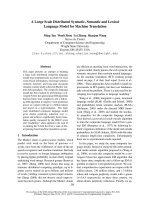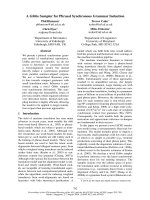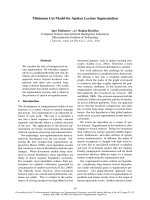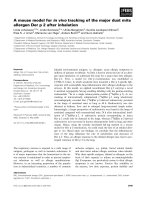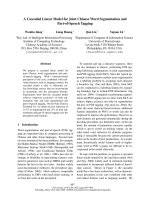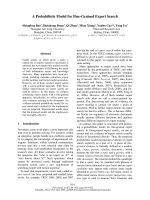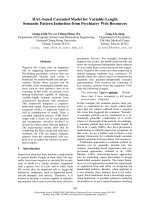Báo cáo khoa học: "HAL-based Cascaded Model for Variable-Length Semantic Pattern Induction from Psychiatry Web Resources" pdf
Bạn đang xem bản rút gọn của tài liệu. Xem và tải ngay bản đầy đủ của tài liệu tại đây (140.97 KB, 8 trang )
Proceedings of the COLING/ACL 2006 Main Conference Poster Sessions, pages 945–952,
Sydney, July 2006.
c
2006 Association for Computational Linguistics
HAL-based Cascaded Model for Variable-Length
Semantic Pattern Induction from Psychiatry Web Resources
Liang-Chih Yu and Chung-Hsien Wu
Department of Computer Science and Information Engineering
National Cheng Kung University
Tainan, Taiwan, R.O.C.
{lcyu, chwu}@csie.ncku.edu.tw
Fong-Lin Jang
Department of Psychiatry
Chi-Mei Medical Center
Tainan, Taiwan, R.O.C.
Abstract
Negative life events play an important
role in triggering depressive episodes.
Developing psychiatric services that can
automatically identify such events is
beneficial for mental health care and pre-
vention. Before these services can be
provided, some meaningful semantic pat-
terns, such as <lost, parents>, have to be
extracted. In this work, we present a text
mining framework capable of inducing
variable-length semantic patterns from
unannotated psychiatry web resources.
This framework integrates a cognitive
motivated model, Hyperspace Analog to
Language (HAL), to represent words as
well as combinations of words. Then, a
cascaded induction process (CIP) boot-
straps with a small set of seed patterns
and incorporates relevance feedback to
iteratively induce more relevant patterns.
The experimental results show that by
combining the HAL model and relevance
feedback, the CIP can induce semantic
patterns from the unannotated web cor-
pora so as to reduce the reliance on anno-
tated corpora.
1 Introduction
Depressive disorders have become a major threat
to mental health. People in their daily life may
suffer from some negative or stressful life events,
such as death of a family member, arguments
with a spouse, loss of a job, and so forth. Such
life events play an important role in triggering
depressive symptoms, such as depressed mood,
suicide attempts, and anxiety. Therefore, it is
desired to develop a system capable of identify-
ing negative life events to provide more effective
psychiatric services. For example, through the
negative life events, the health professionals can
know the background information about subjects
so as to make more correct decisions and sugges-
tions. Negative life events are often expressed in
natural language segments (e.g., sentences). To
identify them, the critical step is to transform the
segments into machine-interpretable semantic
representation. This involves the extraction of
key semantic patterns from the segments. Con-
sider the following example.
Two years ago, I lost
my parents. (Event)
Since that, I have attempted to kill myself
several times. (Suicide)
In this example, the semantic pattern <lost, par-
ents> is constituted by two words, which indi-
cates that the subject suffered from a negative
life event that triggered the symptom “Suicide”.
A semantic pattern can be considered as a se-
mantically plausible combination of k words,
where k is the length of the pattern. Accordingly,
a semantic pattern may have variable length. In
Wu et al.’s study (2005), they have presented a
methodology to identify depressive symptoms. In
this work, we go a further step to devise a text
mining framework for variable-length semantic
pattern induction from psychiatry web resources.
Traditional approaches to semantic pattern in-
duction can be generally divided into two
streams: knowledge-based approaches and cor-
pus-based approaches (Lehnert et al., 1992;
Muslea, 1999). Knowledge-based approaches
rely on exploiting expert knowledge to design
handcrafted semantic patterns. The major limita-
tions of such approaches include the requirement
of significant time and effort on designing the
handcrafted patterns. Besides, when applying to
a new domain, these patterns have to be redes-
igned. Such limitations form a knowledge acqui-
sition bottleneck. A possible solution to reducing
the problem is to use a general-purpose ontology
945
such as WordNet (Fellbaum, 1998), or a domain-
specific ontology constructed using automatic
approaches (Yeh et al., 2004). These ontologies
contain rich concepts and inter-concept relations
such as hypernymy-hyponymy relations. How-
ever, an ontology is a static knowledge resource,
which may not reflect the dynamic characteris-
tics of language. For this consideration, we in-
stead refer to the web resources, or more restrict-
edly, the psychiatry web resources as our knowl-
edge resource.
Corpus-based approaches can automatically
learn semantic patterns from domain corpora by
applying statistical methods. The corpora have to
be annotated with domain-specific knowledge
(e.g., events). Then, various statistical methods
can be applied to induce variable-length semantic
patterns from all possible combinations of words
in the corpora. However, statistical methods may
suffer from data sparseness problem, thus they
require large corpora with annotated information
to obtain more reliable parameters. For some ap-
plication domains, such annotated corpora may
be unavailable. Therefore, we propose the use of
web resources as the corpora. When facing with
the web corpora, traditional corpus-based ap-
proaches may be infeasible. For example, it is
impractical for health professionals to annotate
the whole web corpora. Besides, it is also im-
practical to enumerate all possible combinations
of words from the web corpora, and then search
for the semantic patterns.
To address the problems, we take the notion of
weakly supervised (Stevenson and Greenwood,
2005) or unsupervised learning (Hasegawa, 2004;
Grenager et al., 2005) to develop a framework
able to bootstrap with a small set of seed patterns,
and then induce more relevant patterns form the
unannotated psychiatry web corpora. By this
way, the reliance on annotated corpora can be
significantly reduced. The proposed framework
is divided into two parts: Hyperspace Analog to
Language (HAL) model (Burgess et al., 1998;
Bai et al., 2005), and a cascaded induction proc-
ess (CIP). The HAL model, which is a cognitive
motivated model, provides an informative infra-
structure to make the CIP capable of learning
from unannotated corpora. The CIP treats the
variable-length induction task as a cascaded
process. That is, it first induces the semantic pat-
terns of length two, then length three, and so on.
In each stage, the CIP initializes the set of se-
mantic patterns to be induced based on the better
results of the previous stage, rather than enumer-
ating all possible combinations of words. This
would be helpful to avoid noisy patterns propa-
gating to the next stage, and the search space can
also be reduced.
A crucial step for semantic pattern induction is
the representation of words as well as combina-
tions of words. The HAL model constructs a
high-dimensional context space for the psychia-
try web corpora. Each word in the HAL space is
represented as a vector of its context words,
which means that the sense of a word can be in-
ferred through its contexts. Such notion is de-
rived from the observation of human behavior.
That is, when an unknown word occurs, human
beings may determine its sense by referring to
the words appearing in the contexts. Based on
the cognitive behavior, if two words share more
common contexts, they are more semantically
similar. To further represent a semantic pattern,
the HAL model provides a mechanism to com-
bine its constituent words over the HAL space.
Once the HAL space is constructed, the CIP
takes as input a seed pattern per run, and in turn
induces the semantic patterns of different lengths.
For each length, the CIP first creates the initial
set based on the results of the previous stage.
Then, the induction process is iteratively per-
formed to induce more patterns relevant to the
given seed pattern by comparing their context
distributions. In addition, we also incorporate
expert knowledge to guide the induction process
by using relevance feedback (Baeza-Yates and
Ribeiro-Neto, 1999), the most popular query re-
formulation strategy in the information retrieval
(IR) community. The induction process is termi-
nated until the termination criteria are satisfied.
In the remainder of this paper, Section 2 pre-
sents the overall framework for variable-length
semantic pattern induction. Section 3 describes
the process of constructing the HAL space. Sec-
tion 4 details the cascaded induction process.
Section 5 summarizes the experiment results.
Finally, Section 6 draws some conclusions and
suggests directions for future work.
2 Framework for Variable-Length Se-
mantic Pattern Induction
The overall framework, as illustrated in Figure 1,
is divided into two parts: the HAL model and the
cascaded induction process. First of all, the HAL
space is constructed for the psychiatry web
corpora after word segmentation. Then, each
word in HAL space is evaluated by computing its
distance to a given seed pattern. A smaller
distance represents that the word is more
946
Distance
Evaluation
Stop
Induced
Patterns
Psychiatry
Web Corpora
HAL Space
Construction
Seed
Patterns
Word
Segmentation
HAL model
Iteration +1
Quality
Concepts
length 2 length 3 length k
No
Relevance
Feedback
Iteration=0
Initial Set
(length k)
Yes
k +1
Cascaded Induction Process
Induced
Patterns
Relevant
Patterns
Figure 1. Framework for variable-length seman-
tic pattern induction.
semantically related to the seed pattern.
According to the distance measure, the CIP
generates quality concepts, i.e., a set of
semantically related words to the seed pattern.
The quality concepts and the better semantic
patterns induced in the previous stage are
combined to generate the initial set for each
length. For example, in the beginning stage, i.e.,
length two, the initial set is the all possible
combinations of two quality concepts. In the later
stages, each initial set is generated by adding a
quality concept to each of the better semantic
patterns. After the initial set for a particular
length is created, each semantic pattern and the
seed pattern are represented in the HAL space for
further computing their distance. The more
similar the context distributions between two
patterns, the closer they are. Once all the
semantic patterns are evaluated, the relevance
feedback is applied to provide a set of relevant
patterns judged by the health professionals.
According to the relevant information, the seed
pattern can be refined to be more similar to the
relevant set. The refined seed pattern will be
taken as the reference basis in the next iteration.
The induction process for each stage is
performed iteratively until no more patterns are
judged as relevant or a maximum number of
iteration is reached. The relevant set produced at
the last iteration is considered as the result of the
semantic patterns.
3 HAL Space Construction
The HAL model represents each word in the vo-
cabulary using a vector representation. Each
w
1
w
2
w
l
-2
w
l
-1
w
l
Observation window of length
weight =1
2
Figure 2. Weighting scheme of the HAL model.
two years ago I lost my parents
two 0 0 0 0 0 0 0
years 5 0 0 0 0 0 0
ago 4 5 0 0 0 0 0
I 3 4 5 0 0 0 0
lost 2 3 4 5 0 0 0
my 1 2 3 4 5 0 0
parents 0 1 2 3 4 5 0
Table 1. Example of HAL Space (window size=5)
dimension of the vector is a weight representing
the strength of association between the target
word and its context word. The weights are com-
puted by applying an observation window of
length l over the corpus. All words within the
window are considered as co-occurring with each
other. Thus, for any two words of distance d
within the window, the weight between them is
computed as
1ld
−
+ . Figure 2 shows an exam-
ple. The HAL space views the corpus as a se-
quence of words. Thus, after moving the window
by one word increment over the whole corpus,
the HAL space is constructed. The resultant HAL
space is an
N
N
×
matrix, where N is the vo-
cabulary size. In addition, each word in the HAL
space is called a concept. Table 1 presents the
HAL space for the example text “Two years ago,
I lost my parents.”
3.1 Representation of a Single Concept
For each concept in Table 1, the correspond-
ing row vector represents its left context infor-
mation, i.e., the weights of the words preceding it.
Similarly, the corresponding column vector
represents its right context information. Accord-
ingly, each concept can be represented by a pair
of vectors. That is,
()
12 1 2
(, )
, , . . . , , , , . . . , ,
ii
i i iN i i iN
left right
icc
left left left right right right
ct ct ct ct ct ct
cvv
ww w w w w
=
=
(1)
where
i
left
c
v
and
i
right
c
v
represent the vectors of the
left context information and right context infor-
mation of a concept
i
c , respectively,
ij
ct
w
denotes
947
11 1
N
Left Context
left left
ct ct
ww
1
c
N
c
.
.
.
11 1
N
Right Context
right right
ct ct
ww
Figure 3. Conceptual representation of the HAL
space.
the weight of the
j-th dimension (
j
t ) of a vector,
and
N is the dimensionality of a vector, i.e., vo-
cabulary size. The conceptual representation is
depicted in Figure 3.
The weighting scheme of the HAL model is
frequency-based. For some extremely infrequent
words, we consider them as noises and remove
them from the vocabulary. On the other hand, a
high frequent word tends to get a higher weight,
but this does not mean the word is informative,
because it may also appear in many other vectors.
Thus, to measure the informativeness of a word,
the number of the vectors the word appears in
should be taken into account. In principle, the
more vectors the word appears in, the less infor-
mation it carries to discriminate the vectors. Here
we use a weighting scheme analogous to TF-IDF
(Baeza-Yates and Ribeiro-Neto, 1999) to re-
weight the dimensions of each vector, as de-
scribed in Equation (2).
*log ,
()
ij ij
vector
ct ct
j
N
ww
vf t
= (2)
where
vector
N denotes the total number of vectors,
and ( )
j
vf t denotes the number of vectors with
j
t
as the dimension. After each dimension is re-
weighted, the HAL space is transformed into a
probabilistic framework. Accordingly, each
weight can be redefined as
(|) ,
ij
ij
ij
ct
ct j i
ct
j
w
wPtc
w
≡=
∑
(3)
where
(|)
j
i
P
tc
is the probability that
j
t appears
in the vector of
i
c .
3.2 Concept Combination
A semantic pattern is constituted by a set of con-
cepts, thus it can be represented through concept
combination over the HAL space. This forms a
new concept in the HAL space. Let
1
( , , )
S
s
pc c
=
be a semantic pattern with S con-
stituent concepts, i.e., length S. The concept
combination is defined as
12 3
(( ( ) ) ),
sS
cccc c
⊕
≡⊕⊕⊕⊕ (4)
where
⊕
denotes the symbol representing the
combination operator over the HAL space,
s
c
⊕
denotes a new concept generated by the concept
combination. The new concept is the representa-
tion of a semantic pattern, also a vector represen-
tation. That is,
()
11
() () () ()
(, )
, . . . , , , . . . , ,
ss
ssNssN
left right
scc
left left right right
ct ct ct ct
cvv
wwww
⊕⊕
⊕⊕⊕⊕
⊕=
=
(5)
The combination operator,
⊕ , is implemented
by the product of the weights of the constituent
concepts, described as follows.
()
1
1
( | ),
sj sj
S
ct ct
s
S
j
s
s
ww
Pt c
⊕
=
=
=
=
∏
∏
(6)
where
()
s
j
ct
w
⊕
denotes the weight of the j-th di-
mension of the new concept
s
c⊕ .
4 Cascaded Induction Process
Given a seed pattern, the CIP is to induce a set of
relevant semantic patterns with variable lengths
(from 2 to
k). Let
1
( , , )
s
eed R
s
pcc=
be a seed
pattern of length R, and
1
( , , )
S
s
pc c= be a
semantic pattern of length S. The formal
description of the CIP is presented as
{
}
{} ()
11
|
( , , ) | ( , , ) iff , ,
seed
RS rs
sp sp
cc cc Distcc
λ
−
≡
−∀⊕⊕≤
(7)
where |
−
denotes the symbol representing the
cascaded induction,
r
c
⊕
and
s
c⊕ are the two
new concepts representing
s
eed
s
p and
s
p , respec-
tively, and ( , )
Dist ii represents the distance
between two semantic patterns. The main steps
in the CIP include the
initial set generation, dis-
tance measure
, and relevance feedback.
4.1 Initial Set Generation
The initial set for a particular length contains a
set of semantic patterns to be induced, i.e., the
search space. Reducing the search space would
be helpful for speeding up the induction process,
948
especially for inducing those patterns with a lar-
ger length. For this purpose, we consider that the
words and the semantic patterns similar to a
given seed pattern are the better candidates for
creating the initial sets. Therefore, we generate
quality concepts, a set of semantically related
words to a seed pattern, as the basis to create the
initial set for each length. Thus, each seed pattern
will be associated with a set of quality concepts.
In addition, the better semantic patterns induced
in the previous stage are also considered. The
goodness of words and semantic patterns is
measured by their distance to a seed pattern.
Here, a word is considered as a quality concept if
its distance is smaller than the average distance
of the vocabulary. Similarly, only the semantic
patterns with a distance smaller than the average
distance of all semantic patterns in the previous
stage are preserved to the next stage. By the way,
the semantically unrelated patterns, possibly
noisy patterns, will not be propagated to the next
stage, and the search space can also be reduced.
The principles of creating the initial sets of se-
mantic patterns are summarized as follows.
• In the beginning stage, the aim is to cre-
ate the initial set for the semantic pat-
terns with length two. Thus, the initial
set is the all possible combinations of
two quality concepts.
• In the latter stages, each initial set is cre-
ated by adding a quality concept to each
of the better semantic patterns induced in
the previous stage.
4.2 Distance Measure
The distance measure is to measure the distance
between the seed patterns and semantic patterns
to be induced. Let
1
( , , )
S
s
pc c= be a semantic
pattern and
1
( , , )
s
eed R
s
pcc=
be a given seed
pattern, their distance is defined as
()
,(,),
s
eed s r
D
ist sp sp Dist c c=⊕⊕ (8)
where ( , )
s
r
Dist c c⊕⊕ denotes the distance be-
tween two semantic patterns in the HAL space.
As mentioned earlier, after concept combination,
a semantic pattern becomes a new concept in the
HAL space, which means the semantic pattern
can be represented by its left and right contexts.
Thus, the distance between two semantic patterns
can be computed through their context distance.
Equation (8) thereby can be written as
(
)
,(,)(,).
sr s r
left left Right Right
seed c c c c
Dist sp sp Dist v v Dist v v
⊕⊕ ⊕ ⊕
=+
(9)
Because the weights of the vectors are repre-
sented using a probabilistic framework, each
vector of a concept can be considered as a prob-
abilistic distribution of the context words. Ac-
cordingly, we use the
Kullback-Liebler (KL) dis-
tance
(Manning and Schütze, 1999) to compute
the distance between two probabilistic distribu-
tions, as shown in the following.
1
()
()()log ,
()
sr
N
js
cc js
j
jr
Pt c
Dv v Pt c
Pt c
⊕⊕
=
⊕
=⊕
⊕
∑
(10)
where
( )D ii denotes the KL distance be-
tween two probabilistic distributions. When
Equation (10) is ill-conditioned, i.e., zero de-
nominator, the denominator will be set to a small
value (10
-6
). For the consideration of a symmet-
ric distance, we use the divergence measure,
shown as follows.
(,) ( )( ).
sr sr r s
cc cc cc
Div v v D v v D v v
⊕⊕ ⊕⊕ ⊕⊕
=+ (11)
By this way, the distance between two probabil-
istic distributions can be computed by their KL
divergence. Thus, Equation (9) becomes
(,) (,) ( , ).
sr sr s r
left left Right Right
cc cc c c
Dist v v Div v v Div v v
⊕⊕ ⊕⊕ ⊕ ⊕
=+
(12)
After each semantic pattern is evaluated, a
ranked list is produced for relevance judgment.
4.3 Relevance Feedback
In the induction process, some non-relevant se-
mantic patterns may have smaller distance to a
seed pattern, which may decrease the precision
of the final results. To overcome the problem,
one possible solution is to incorporate expert
knowledge to guide the induction process. For
this purpose, we use the technique of relevance
feedback. In the IR community, the relevance
feedback is to enhance the original query from
the users by indicating which retrieved docu-
ments are relevant. For our task, the relevance
feedback is applied after each semantic pattern is
evaluated. Then, the health professionals judge
which semantic patterns are relevant to the seed
pattern. In practice, only the top
n semantic pat-
terns are presented for relevance judgment. Fi-
nally, the semantic patterns judged as relevant
are considered to form the relevant set, and the
others form the non-relevant set. According to
the relevant and non-relevant information, the
seed pattern can be refined to be more similar to
the relevant set, such that the induction process
can induce more relevant patterns and move
away from noisy patterns in the future iterations.
949
The refinement of the seed pattern is to adjust
its context distributions
(left and right). Such ad-
justment is based on re-weighting the dimensions
of the context vectors of the seed pattern. The
dimensions more frequently regarded as relevant
patterns are more significant for identifying rele-
vant patterns. Hence, such dimensions of the
seed pattern should be emphasized. The signifi-
cance of a dimension is measured as follows.
()
()
() ,
ik
i
jk
j
ct
cR
k
ct
cR
w
Sig t
w
⊕
⊕∈
⊕
⊕∈
=
∑
∑
(13)
where
()
k
Sig t
denotes the significance of the di-
mension
k
t
,
i
c⊕
and
j
c⊕
denote the semantic
patterns of the relevant set and non-relevant set,
respectively, and
()
ik
ct
w
⊕
and
()
j
k
ct
w
⊕
denote the
weights of
k
t
of
i
c⊕
and
j
c⊕
, respectively. The
higher the ratio, the more significant the dimen-
sion is. In order to smooth
()
k
Sig t
to the range
from zero to one, the following formula is used:
1
() ()
1
() .
1
ik jk
i
j
k
ct c t
cR
cR
Sig t
ww
−
⊕⊕
⊕∈
⊕∈
=
⎛⎞
⎜⎟
+
⎜⎟
⎝⎠
∑∑
(14)
The corresponding dimension of the seed pattern
s
eed r
s
pc=⊕ is then re-weighted by
() ()
().
rk rk
ct ct k
wwSigt
⊕⊕
=+
(15)
Once the context vectors of the seed pattern
are re-weighted, they are also transformed into a
probabilistic form using Equation (3). The re-
fined seed pattern will be taken as the reference
basis in the next iteration. The relevance feed-
back is performed iteratively until no more se-
mantic patterns are judged as relevant or a
maximum number of iteration is reached. At the
same time, the induction process for a particular
length is also stopped. The whole CIP process is
stopped until the seed patterns are exhausted
5 Experimental Results
To evaluate the performance of the CIP, we built
a prototype system and provided a set of seed
patterns. The seed patterns were collected by re-
ferring to the well-defined instruments for as-
sessing negative life events (Brostedt and Peder-
sen, 2003; Pagano et al., 2004). A total of 20
seed patterns were selected by the health profes-
sionals. Then, the CIP randomly selects one seed
pattern per run without replacement from the
seed set, and iteratively induces relevant patterns
from the psychiatry web corpora. The psychiatry
web corpora used here include some professional
mental health web sites, such as PsychPark
(
) (Bai, 2001) and John
Tung Foundation (
).
In the following sections, we describe some
experiments to in turn examine the effect of us-
ing relevance feedback or not, and the coverage
on real data using the semantic patterns induced
by different approaches. Because the semantic
patterns with a length larger than 4 are very rare
to express a negative life event, we limit the
length
k to the range of 2 to 4.
5.1 Evaluation on Relevance Feedback
The relevance feedback employed in this study
provides the relevant and non-relevant informa-
tion for the CIP so that it can refine the seed pat-
tern to induce more relevant patterns. The rele-
vance judgment is carried out by three experi-
enced psychiatric physicians. For practical con-
sideration, only the top 30 semantic patterns are
presented to the physicians. During relevance
judgment, a majority vote mechanism is used to
handle the disagreements among the physicians.
That is, a semantic pattern is considered as rele-
vant if any two or more physicians judged it as
relevant. Finally, the semantic patterns with ma-
jority votes are obtained to form the relevant set.
To evaluate the effectiveness of the relevance
feedback, we construct three variants of the CIP,
RF(5), RF(10), and RF(20), implemented by ap-
plying the relevance feedback for 5, 10, and 20
iterations, respectively. These three CIP variants
are then compared to the one without using the
relevance feedback, denoted as
RF(
-)
. We use
the evaluation metric,
precision at 30 (prec@30),
over all seed patterns to examine if the relevance
feedback can help the CIP induce more relevant
patterns. For a particular seed pattern, prec@n is
computed as the number of relevant semantic
patterns ranked in the top
n of the ranked list,
divided by
n. Table 2 presents the results for k=2.
The results reveal that the relevance feedback
can help the CIP induce more relevant semantic
patterns. Another observation indicates that ap-
plying the relevance feedback for more iterations
RF(
-)
RF(5) RF(10) RF(20)
prec@30 0.203 0.263 0.318 0.387
Table 2. Effect of applying relevance feedback
for different number of iterations or not.
950
0.15
0.2
0.25
0.3
0.35
0.4
0.45
0 5 10 15 20 25 30 35 40 45 50
Num. of Iterations
prec@30
RF(10)+pseudo
RF(20)
RF(─)
Figure 4. Effect of using the combination of rele-
vance feedback and pseudo-relevance feedback.
can further improve the precision. However, it is
usually impractical for experts to involve in the
guiding process for too many iterations. Conse-
quently, we further consider
pseudo-relevance
feedback
to automate the guiding process. The
pseudo-relevance feedback carries out the rele-
vance judgment based on the assumption that the
top ranked semantic patterns are more likely to
be the relevant ones. Thus, this approach usually
relies on setting a threshold or selecting only the
top
n semantic patterns to form the relevant set.
However, determining the threshold is not trivial,
and the threshold may be different with different
seed patterns. Therefore, we apply the pseudo-
relevance feedback only after certain expert-
guided iterations, rather than applying it
throughout the induction process. The notion is
that we can get a more reliable threshold value
by observing the behavior of the relevant seman-
tic patterns in the ranked list for a few iterations.
To further examine the effectiveness of the
combined approach, we additionally construct a
CIP variant,
RF(10)+pseudo, by applying the
pseudo-relevance feedback after 10 expert-
guided iterations. The threshold is determined by
the physicians during their judgments in the 10-
th iteration. The results are presented in Figure 4.
The precision of
RF(10)+pseudo is inferior to
that of
RF(20) before the 25-th iteration. Mean-
while, after the 30-th iteration,
RF(10)+pseudo
achieves higher precision than the other methods.
This indicates that the pseudo-relevance feed-
back can also contribute to semantic pattern in-
duction in the stage without expert intervention.
5.2 Coverage on Real Data
The final results of the semantic patterns are the
relevant sets of the last iteration produced by
RF(10)+pseudo, denoted as
CIP
SP
. Parts of them
are shown in Table 3.
Seed
Pattern
< boyfriend, argue >
Induced
Patterns
<girlfriend, break up>; <friend, fight>
Table 3. Parts of induced semantic patterns.
We compare
CIP
SP
to those created by a
corpus-based approach. The corpus-based ap-
proach relies on an annotated domain corpus and
a learning mechanism to induce the semantic
patterns. Thus, we collected 300 consultation
records from the PsychPark as the domain corpus,
and each sentence in the corpus is annotated with
a negative life event or not by the three physi-
cians. After the annotation process, the sentences
with negative life events are together to form the
training set. Then, we adopt
Mutual Information
(Manning and Schütze, 1999) to learn variable-
length semantic patterns. The mutual information
between
k words is defined as
1
11
1
( , , )
(, , ) (, , )log
()
k
kk
k
i
i
Pw w
MI w w P w w
Pw
=
=
∏
(16)
where
1
( , )
k
Pw w is the probability of the k
words co-occurring in a sentence in the training
set, and ( )
i
Pw is the probability of a single word
occurring in the training set. Higher mutual in-
formation indicates that the
k words are more
likely to form a semantic pattern of length
k.
Here the length
k also ranges from 2 to 4. For
each
k, we compute the mutual information for
all possible combinations of words in the training
set, and those with their mutual information
above a threshold are selected to be the final re-
sults of the semantic patterns, denoted as
M
I
SP
.
In order to obtain reliable mutual information
values, only words with at least the minimum
number of occurrences (>5) are considered.
To examine the coverage of
CIP
SP
and
M
I
SP
on
real data, 15 human subjects are involved in cre-
ating a test set. The subjects provide their experi-
enced negative life events in the form of natural
language sentences. A total of 69 sentences are
collected to be the test set, of which 39 sentences
contain a semantic pattern of length two, 21 sen-
tences contain a semantic pattern of length three,
and 9 sentences contain a semantic pattern of
length four. The evaluation metric used is
out-of-
pattern (OOP)
rate, a ratio of unseen patterns
occurring in the test set. Thus, the OOP can be
defined as the number of test sentences contain-
ing the semantic patterns not occurring in the
training set, divided by the total number of sen-
tences in the test set. Table 4 presents the results.
951
k=2 k=3 k=4
CIP
SP
0.36 (14/39) 0.48 (10/21) 0.44 (4/9)
M
I
SP
0.51 (20/39) 0.62 (13/21) 0.67 (6/9)
Table 4. OOP rate of the CIP and a corpus-based
approach.
The results show that the OOP of
M
I
SP
is
higher than that of
CIP
SP
. The main reason is the
lack of a large enough domain corpus with anno-
tated life events. In this circumstance, many se-
mantic patterns, especially for those with a larger
length, could not be learned, because the number
of their occurrences would be very rare in the
training set. With no doubt, one could collect a
large amount of domain corpus to reduce the
OOP rate. However, increasing the amount of
domain corpus also increases the amount of an-
notation and computation complexity. Our ap-
proach, instead, exploits the quality concepts to
reduce the search space, also applies the rele-
vance feedback to guide the induction process,
thus it can achieve better results with time-
limited constraints.
6 Conclusion
This study has presented an HAL-based cascaded
model for variable-length semantic pattern in-
duction. The HAL model provides an informa-
tive infrastructure for the CIP to induce semantic
patterns from the unannotated psychiatry web
corpora. Using the quality concepts and preserv-
ing the better results from the previous stage, the
search space can be reduced to speed up the in-
duction process. In addition, combining the rele-
vance feedback and pseudo-relevance feedback,
the induction process can be guided to induce
more relevant semantic patterns. The experimen-
tal results demonstrated that our approach can
not only reduce the reliance on annotated corpora
but also obtain acceptable results with time-
limited constraints. Future work will be devoted
to investigating the detection of negative life
events using the induced patterns so as to make
the psychiatric services more effective.
References
R. Baeza-Yates and B. Ribeiro-Neto. 1999. Modern
Information Retrieval. Addison-Wesley, Reading,
MA.
Y. M. Bai, C. C. Lin, J. Y. Chen, and W. C. Liu. 2001.
Virtual Psychiatric Clinics. American Journal of
Psychiatry, 158(7):1160-1161.
J. Bai, D. Song, P. Bruza, J. Y. Nie, and G. Cao. 2005.
Query Expansion Using Term Relationships in
Language Models for Information Retrieval. In
Proc. of the 14th ACM International Conference
on Information and Knowledge Management,
pages 688-695.
E. M. Brostedt and N. L. Pedersen. 2003. Stressful
Life Events and Affective Illness. Acta Psychiat-
rica Scandinavica, 107:208-215.
C. Burgess, K. Livesay, and K. Lund. 1998. Explora-
tions in Context Space: Words, Sentences, Dis-
course. Discourse Processes. 25(2&3):211-257.
C. Fellbaum. 1998. WordNet: An Electronic Lexical
Database. Cambridge, MA: MIT Press.
T. Grenager, D. Klein, and C. D. Manning. 2005. Un-
supervised Learning of Field Segmentation Models
for Information Extraction. In Proc. of the 43th
Annual Meeting of the ACL, pages 371-378.
T. Hasegawa, S. Sekine, R. Grishman. 2004. Discov-
ering Relations among Named Entities from Large
Corpora. In Proc. of the 42th Annual Meeting of
the ACL, pages 415-422.
W.Lehnert, C. Cardie, D. Fisher, J. McCarthy, E.
Riloff, and S. Soderland. 1992. University of Mas-
sachusetts: Description of the CIRCUS System
used for MUC-4. In Proc. of the Fourth Message
Understanding Conference, pages 282-288.
C. Manning and H. Schütze. 1999. Foundations of
Statistical Natural Language Processing. MIT
Press. Cambridge, MA.
I. Muslea. 1999. Extraction Patterns for Information
Extraction Tasks: A Survey. In Proc. of the AAAI-
99 Workshop on Machine Learning for Information
Extraction, pages 1-6.
M. E. Pagano, A. E. Skodol, R. L. Stout, M. T. Shea,
S. Yen, C. M. Grilo, C.A. Sanislow, D. S. Bender,
T. H. McGlashan, M. C. Zanarini, and J. G. Gun-
derson. 2004. Stressful Life Events as Predictors of
Functioning: Findings from the Collaborative Lon-
gitudinal Personality Disorders Study. Acta Psy-
chiatrica Scandinavica, 110:421-429.
M. Stevenson and M. A. Greenwood. 2005. A Seman-
tic Approach to IE Pattern Induction. In Proc. of
the 43th Annual Meeting of the ACL, pages 379-
386.
C. H. Wu, L. C. Yu, and F. L. Jang. 2005. Using Se-
mantic Dependencies to Mine Depressive Symp-
toms from Consultation Records. IEEE Intelligent
System, 20(6):50-58.
J. F. Yeh, C. H. Wu, M. J. Chen, and L. C. Yu. 2004.
Automated Alignment and Extraction of Bilingual
Domain Ontology for Cross-Language Domain-
Specific Applications. In Proc. of the 20th COL-
ING, pages 1140-1146.
952

